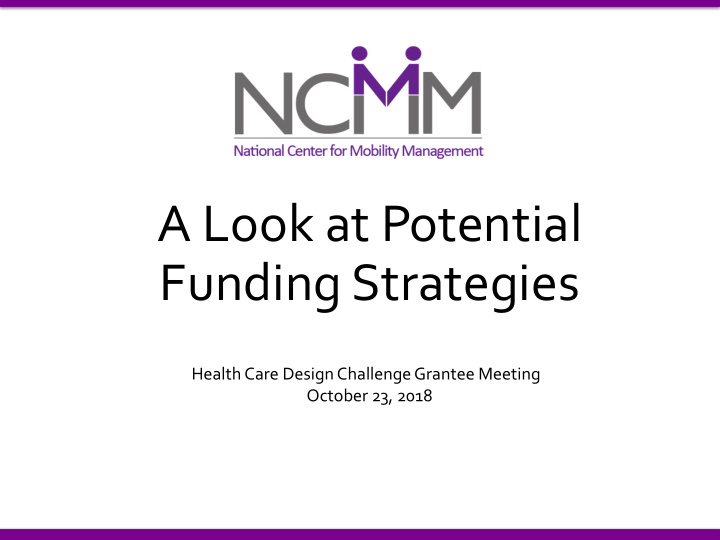



A Look at Potential Funding Strategies Health Care Design Challenge Grantee Meeting October 23, 2018
Framing “Funding” How does transit get credit from the positive outcomes it generates in communities? We provide access to employment, healthcare, education, housing, services How can we show the value of our services, and capture investment to support new and innovative programs focused on transportation. We need to think bigger…
Let’s think creatively about funding! Transit as an INVESTMENT
Partnerships! Partnerships! Partnerships!
Framing question: Think of your solution, what are you trying to pay for and over what time frame? This could be: • Capital Project • Staffing costs • Backbone/integrative activities • Technology • Etc. Take a few minutes to explore this question in relation to your proposed solution. Use Worksheet #1 if it is helpful.
Typology of Financing Structures Seed: - Grants Debt & Working Capital: - Bonds/loans - Pay for Success Sustainable: - Health Care Payment Model - Reinvestment - Anchor Institutions - Public Revenues (taxes, tax credits, fees)
Typology of Financing Structures Seed: - Grants Debt & Working Capital: - Bonds/loans - Pay for Success Sustainable: - Health Care Payment Model - Reinvestment - Anchor Institutions - Public Revenues (taxes, tax credits, fees)
Grants “Arrangements that provide one time or short-term funding for specific initiatives” Most Suited For: Up front costs, one-time projects or costs Why Important: Can spur innovation by providing funds for investments too risky for other funders; can be building blocks for leveraging additional funding Challenges: Short term, terms of the grant are not always consistence with grantee’s core work
Innovative Coordinated Access and Mobility (ICAM) Pilot Program On September 12, 2018, FTA announced the availability of $6.3 million in competitive grant funds for transit coordination projects that improve access to healthcare (Access and Mobility Partnership Grants). The grants will help improve options for people with limited transportation choices and bridge the gap between service providers in the transportation and health sectors. Innovative Coordinated Access & Mobility (ICAM) Pilot Program • Human Services Coordination Research (HSCR) Grants • Applications are due November 13, 2018. More information is available here: https://www.transit.dot.gov/funding/grants/grant-programs/access-and- mobility-partnership-grants
The Foundation Center is a national clearinghouse of foundations, including their mission, grant procedures, and previous recipients . http://foundationcenter.org
Anchor Institutions “Institutions make resources allocation decisions across the enterprise that prioritize health and wellbeing of the community” Who: Health systems, Universities, Employers, etc. Most Suited For: Communities with large institutions that impact the well-being of the community, or interventions typically related to business functions Why Important: Large Institutions can significantly impact social determinants of health Challenges: Institutions must determine that serving as an anchor fulfills their mission and/or there is a business case
Community Example: The MetroHealth line • The MetroHealth System (Cleveland, OH) • 5-year plan to revitalize the surrounding neighborhood • MetroHealth Line runs directly to the hospital and clinics • 20 new buses, 400 bus stops, and 37 bus shelters 13
Your Turn! Apply your Expertise! Alone or with your colleagues a) Review worksheet 1 and your areas in need of funding b) With that in mind, look through typology or think of the examples I have covered and identify a financing structure you are interested in exploring c) Work through the questions on Worksheet #2
https://www.rethinkhealth.org/
Group Discussion Image Credit: https://goo.gl/images/whXcqM
Recommend
More recommend